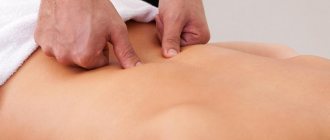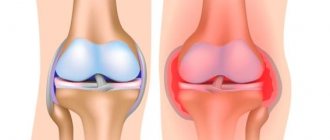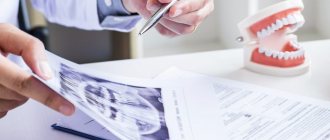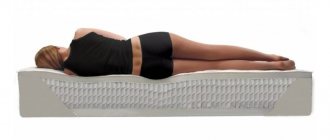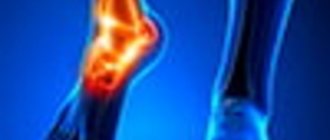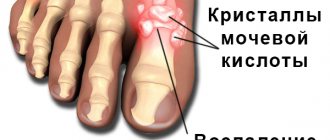Cervical lumbago, or cervicago, is a fairly common reflex syndrome of cervical osteochondrosis. The cause of acute piercing pain, which intensifies when turning or tilting the head, is also caused by protrusions, hernias, and previous injuries. Any of the pathologies can quickly progress and spread to nearby healthy vertebral structures. If you have a shot in the neck, you should immediately consult a doctor for treatment.
Types of neck lumbago
Shooting in the neck varies in the location of the discomfort, its severity and duration. Cervicago often occurs against the background of damage to vertebral structures - intervertebral discs, vertebrae, ligamentous-muscular apparatus. Depending on the area of injury, cervicago clinically manifests itself in the upper, middle or lower part of the neck. Typically, very severe pain occurs in the posterior surface, described by patients as a “lightning strike” or “electric shock”. Despite the fact that its severity gradually decreases, the discomfort remains. This condition is called cervicalgia. In the absence of medical intervention, hypothermia or heavy lifting predisposes to cervical lumbago. Cervicagos are classified depending on their origin:
- “shoulder-hand” syndrome is a symptom of glenohumeral periarthritis, which is characterized by irradiation of pain to the cervical spine;
- pectoralis minor syndrome - referred pain in the neck occurs as a result of compression of the neurovascular bundle on the shoulder by the pathologically altered pectoralis minor muscle;
- cervical sympathetic syndrome - a set of symptoms that manifest as pain in the back of the head, neck and upper extremities;
- scalene muscle syndrome is a set of disorders that occur when the vessels and nerves passing between the scalene muscles are compressed.
Cervicalgia is more often vertebrogenic, caused by the involvement of nerve structures, usually spinal roots, in the pathological process. Instead of vertebrogenic lumbago, it is provoked by injury or inflammation of the connective tissue structures located in the neck area.
Classification of neck pain
Today, it is customary to distinguish several types of pain in the neck:
- cervicalgia – painful sensations of various types, having a different origin;
- cervicago or cervical lumbago - acute, sudden pain caused by compression of the nerve roots;
- cervicobrachialgia - pain that manifests itself and spreads as it grows to the upper limbs;
- Cervicocranialgia is a general condition in which neck pain and headache are felt simultaneously.
Causes of cervical lumbago
In patients with complaints of episodic or constant lumbago, osteochondrosis is detected in most cases. This degenerative-dystrophic pathology is characterized by the formation of osteophytes (bone growths) to stabilize the cervical spine. They are hard, sharp, squeezing soft tissues and blood vessels when moving.
Osteophytes on x-ray.
Often, injury to connective tissue structures by osteophytes provokes the development of aseptic inflammation, which increases the severity of pain. Complications of osteochondrosis also cause cervicago:
- protrusion - protrusion of the intervertebral disc into the spinal canal without rupture of the fibrous ring;
- intervertebral hernia - protrusion of the disc between the vertebral bodies with disruption of the integrity of the fibrous ring, and sometimes leakage of the nucleus pulposus.
The cause of the lumbago is injuries to the spine in the neck area - subluxations, prolonged compression, severe bruises. Less commonly, pinching of nerve endings results from the formation of malignant or benign tumors.
Risk factors for neck pain
Excessive physical activity usually leads to the development of pathologies clinically manifested by shooting in the neck. This includes lifting weights, intense sports training, and frequent monotonous head movements due to the type of work, for example, when working on an assembly line. Initially, minor microtrauma of individual fibers occurs, and then the affected area increases. The cartilage tissue of the discs is destroyed, which causes destructive changes in the cervical structures. Predispose to the appearance of acute pain:
- staying in one position for a long time with your head bowed, including when working at a computer;
- frequent hypothermia;
- congenital and acquired anomalies of the spine (lordosis, kyphosis, scoliosis);
- endocrine pathologies (diabetes mellitus, hypothyroidism), accompanied by dysmetabolic processes;
- frequent stress.
A sedentary lifestyle leads to poor circulation in the cervical vertebral structures. Due to a deficiency of nutrients, trophism is disrupted, provoking the destruction of intervertebral discs with the further formation of osteophytes, protrusions, and hernial protrusions.
Cervical lymphadenitis - symptoms and treatment
Elimination of the primary source of infection
Cervical lymphadenitis is often caused by acute or aggravated periodontitis and complications of advanced caries, such as acute purulent periostitis.
If the tooth can be saved, the root canals are cleaned and filled. If it is impossible to restore a tooth, it is removed. When a purulent focus has formed, the diseased tooth is treated or removed, and the abscess is opened. If cervical lymphadenitis has developed due to a disease of the ENT organs, the source of acute inflammation should also be eliminated.
Drug therapy
- Antibacterial therapy. Broad-spectrum antibiotics are usually used, mainly with a bactericidal effect. The components of such drugs destroy the cell wall of the bacterium or disrupt its metabolic processes, which leads to the death of the microbe. If the patient's condition does not improve, biological material obtained from the lymph node is examined and the sensitivity of microorganisms to drugs is determined.
- Antiviral drugs are used for viral origin of lymphadenitis, for example, herpes.
- Anti-inflammatory drugs suppress inflammation at the cellular level, reduce pain and reduce fever.
- Antihistamines reduce capillary permeability, which prevents the development of edema and congestive processes. They also prevent leukocytes from penetrating into the lesion and inhibit the production of substances that contribute to the development of inflammation.
Physiotherapeutic treatment
- UHF (ultra-high frequency therapy) is aimed at reducing swelling, inflammation and pain.
- Ultrasound is used to speed up the resolution of the inflammatory process.
- UVR (ultraviolet irradiation) is indicated to reduce inflammation.
- Laser therapy is aimed at reducing pain, improving nutrition and blood supply to the affected area.
- Electrophoresis is a method in which a medicinal substance penetrates tissue using a direct electric current. For lymphadenitis, electrophoresis with potassium iodide and proteolytic enzymes is usually performed.
- Magnetic therapy is aimed at reducing pain, inflammation, swelling and congestion in tissues.
Physiotherapeutic methods are used in Russia to reduce the duration of drug treatment, but there is insufficient scientific evidence of their effectiveness.
Surgical intervention
Opening a purulent focus is indicated for purulent forms of lymphadenitis and adenophlegmon. Depending on the size of the lesion, the operation is performed under local or general anesthesia. During surgery, the purulent contents and tissue of the disintegrated lymph node are removed.
After surgical treatment, a drainage is placed in the wound, which ensures the drainage of pus and prevents the edges of the wound from healing. Then the wound is treated, its edges are renewed and sutured.
Detoxification therapy
Reduces the level of toxins in the body by diluting them, absorbing breakdown products and increasing diuresis. To do this, drink more fluid, and in severe cases, Hemodez and Reogluman are administered intravenously.
Diet
It is recommended to eat a balanced diet and consume enough vitamins, macro- and microelements.
Features of treatment of lymphadenitis
Treatment of cervical lymphadenitis directly depends on the stage and form of the disease.
In acute serous lymphadenitis, special attention is paid to the primary source of inflammation: inflammatory diseases of the teeth, oral cavity and ENT organs. If the primary inflammatory process is stopped in the early stages, then the symptoms of acute serous lymphadenitis also become less pronounced.
In almost 98% of cases with acute lymphadenitis, it is possible to identify the primary lesion [10]. It is eliminated and antibacterial, antiviral, anti-inflammatory or antihistamine therapy is prescribed.
When a purulent form develops, the primary focus is eliminated, the abscess is opened and the tissue of the disintegrated lymph node is removed. The patient is usually kept in the hospital under 24-hour observation. Daily dressings are performed, antibacterial, anti-inflammatory, antihistamine and detoxification therapy is prescribed.
In case of chronic hyperplastic lymphadenitis, the affected lymph node is removed, and treatment is also carried out in the hospital. Tissue fragments are sent to the laboratory, processed and examined under a microscope. This procedure allows you to exclude cancer and prevent its development.
Clinical symptoms
The lumbago is manifested by paroxysmal pain in the back of the neck, occurring suddenly. It is so intense that a person is afraid to even turn or tilt his head a little. The acute syndrome is gradually replaced by a dull boring pain, but one awkward movement is enough for a relapse of cervicago. Most often, painful sensations are localized deep in the soft tissues and then radiate to the surface. They also spread to nearby areas of the body:
- shoulders and forearms;
- upper back;
- chin, temple area, forehead.
With osteochondrosis and its complications, pain radiates to the hand and is accompanied by muscle weakness (paresis), sensitivity disorder, and decreased reflexes. Cervicago is always accompanied by neck stiffness and increased skeletal muscle tone, which occurs in response to infringement of sensitive nerve endings. The pain intensifies when trying to change the position of the body, coughing, sneezing, or tensing the abdominal muscles. Patients with cervicago also experience clicking and crackling sounds when turning or tilting the head.
What to do if your neck is “stuck”?
But how can you help yourself in an acute case, when a lumbago occurs or, as they say, “jammed”? Lie down longer in a position that is comfortable for you, allowing all your muscles to relax. Then look what you have:
- analgin,
- pentalgin,
- aspirin.
For the first time, any will do (one tablet three times a day). But then be sure to buy Sirdalud, it relaxes tight muscles well. Practice of the pain department of the clinic named after. A. Ya. Kozhevnikova showed its positive effect already on the third day.
First a bath, then rubbing and massage
Little by little try to turn your head to where the “block” is. If it works, a little stronger. And so gradually the neck will return to its normal position. For the same purpose, take baths at night and light massage of the neck and neck muscles. Throwing your hand over the opposite shoulder, also massage the area of the shoulder blade. Here you need your own sequence: first a bath, then rubbing with Voltaren gel or ointment, then a massage. You can, of course, use ointments such as “Analgos” and “Golden Star” balm if the pungent odor does not irritate you. "Voltaren" has an analgesic and anti-inflammatory effect.
massage
Hold your head like a crystal vase
When you begin to return to normal activities, keep your head like a crystal vase for one to two weeks. Do not carry bags that weigh down your arms; prefer a small backpack. This prolonged rest will help relieve any remaining tension and swelling around previously cramped muscles.
In general, whether it is an acute lumbago or a chronic pain syndrome is already evident, the tactics at the beginning are the same - a gentle regimen. Then, as the pain subsides, therapeutic exercises are needed. This is the same complex of tension in the neck muscles when you try to lower your chin, and your palms are tightly clasped under it, so that your head doesn’t even move. You try to turn it to the side, but your palms again won’t let you. You try to throw it back, but your hands clasped at the back of your head are again on guard. And when you try to tilt your head down, your fists against which your forehead will rest should interfere. This tension-resistance will precisely strengthen the neck muscles, which in women are not very strong by nature.
Gymnastics with turns and bends
The transition to more active gymnastics with head turns is best done based on the doctor’s recommendations. But if gymnastics with turns to the right, left, and bending forward does not give you any problems, you still need to take into account that you cannot tilt your head back. And turns left and right are best done strictly horizontally, as they say, along the line of the tip of the nose.
If you stop doing exercises, the pain may return again and again. And chronic spasm with long-term pain syndrome does not promise anything good in the long term. After working at a desk for a long time, touch your neck muscles with your fingertips and feel how tense they are. We went to the grocery store and it was as if bricks appeared on our shoulders, or, as they also say, “epaulets.”
Diagnostic methods
The primary diagnosis is made based on patient complaints and external examination. The normal static position of the cervical vertebrae has been changed - there is a smoothing of physiological lordosis, forced position of the head, limitation of turns and bends. Upon palpation, compactions are detected, pressure on which leads to painful sensations. The diameter of these structures varies significantly - from a few millimeters to a centimeter, and sometimes more. The density of formations, usually localized in the trapezius muscle, depends on the degree of muscle spasms and the stage of fibrous changes affecting them.
X-ray of the cervical spine.
X-rays are used to detect vertebral deformities and bone growth. Using this study, it is possible to identify spinal abnormalities and the consequences of injury. MRI and CT scans are performed to assess the condition of the cartilage tissue of the disc and the degree of narrowing of the spinal canal. These diagnostic measures are most informative in detecting hernias and neoplasms.
MRI of the cervical spine.
When is it time to seek medical help for neck pain?
Often, a person experiencing pain in any spinal region prefers to refuse to visit a doctor and lets everything take its course. To prevent serious health deterioration, it is important to seek professional help in a timely manner.
Regardless of what type of neck pain is present, it is necessary to consult a specialist and determine the cause of its occurrence.
Special indications to pay attention to are:
- severe headaches;
- traumatic effects on the cervical spine;
- feeling of numbness, weakness in the limbs;
- ineffectiveness of drug use.
Ignoring the symptomatic picture can lead to irreversible consequences that seriously worsen the level of quality of life.
There are situations when a visit to the attending physician is required immediately. These usually include:
- increased body temperature, accompanied by pain in the neck and head;
- severe stiffness of the cervical spine (inability to reach the chest with the chin);
- presence of signs of a heart attack (chest pain, rapid breathing, increased sweating, nausea).
Which specialist should I contact?
If you suspect that previous injuries are the cause of the lumbago, you should make an appointment with a traumatologist. But usually vertebrologists and neurologists treat cervicago and cervicalgia. It wouldn't be a mistake to see a therapist. This doctor will conduct a diagnosis and, after assessing its results, refer the patient to a specialist in the appropriate field.
First aid
During an attack of cervical pain, you should lie down on a hard surface, taking a body position in which the intensity of pain is minimized. In some cases, this requires outside help. Usually the pain subsides when lying on your back with your knees slightly bent. For convenience, a thin pillow or small cushion should be placed under them. Taking a tablet of any non-steroidal anti-inflammatory drug (NSAID) - Nise, Celecoxib, Ketorolac, Ibuprofen - will eliminate pain. If they are not in your home medicine cabinet, then regular Paracetamol will help.
Before the doctor arrives, it is strictly forbidden to apply ice packs, heating pads, or rub warming ointments to the neck. Such procedures can significantly worsen the patient’s well-being.
Treatment options
The choice of treatment method for lumbago in the neck depends on the cause of its occurrence. If cervicago is provoked by an endocrine pathology, then its treatment is carried out simultaneously with the lumbago. Cervical osteochondrosis at the initial stage of development, small hernias and protrusions respond well to conservative therapy.
Conservative treatment
To relieve acute pain, NSAIDs are used in the form of injection solutions. If they are ineffective, drug blockades with anesthetics and hormonal drugs are carried out. As the severity of the pain syndrome decreases, NSAIDs in injections are replaced with tablet forms, and then with gels, ointments, and creams.
Blockade of the cervical spine during shooting.
Therapeutic regimens include systemic chondroprotectors - agents with chondroitin and (or) glucosamine that stimulate the regeneration of cartilage tissue. These are Artra, Teraflex, Dona, Alflutop, Structum, Rumalon.
As the active ingredients accumulate in the cervical vertebral structures, the analgesic, anti-edematous and anti-inflammatory effects of the drugs appear.
| Clinical and pharmacological groups of drugs used in the treatment of lumbago | Names of medicines | pharmachologic effect |
| NSAIDs | Nimesulide (Nimesil), Ketorolac (Ketorol), Diclofenac (Ortofen), Meloxicam (Movalis), Lornoxicam (Xefocam) | Analgesic, anti-inflammatory, antifever |
| Glucocorticosteroids | Triamcinolone, Flosterone, Kenalog, Diprospan, Dexamethasone | Anti-inflammatory, immunosuppressive, antiallergic |
| Muscle relaxants | Mydocalm, Baclofen, Sirdalud, Tolperisone | Reducing skeletal muscle tone, eliminating muscle spasms |
Surgery
If a hernial protrusion or tumor is detected, complicated by neurological disorders, patients are indicated for surgical intervention. Operations are carried out using the following methods:
- laminectomy;
- disectomy;
- foraminotomy;
- decompression of the spinal canal.
Absolute indications for surgical intervention are discogenic myelopathy, persistent radicular syndrome, destructive changes in the carotid artery, and malignant neoplasms.
Physiotherapy
To improve the patient’s well-being, electrophoresis or ultraphonophoresis with hormonal agents, analgesics, NSAIDs, and chondroprotectors is prescribed. After relief of acute, piercing pain and aseptic inflammation, the following physiotherapeutic measures are carried out:
- UHF therapy;
- diadynamic currents;
- magnetic therapy;
- laser therapy.
Treatment of cervical spine pathologies with laser.
In the treatment of cervicago, medicinal leeches, applications with paraffin and ozokerite are used. Methods of manual therapy, balneotherapy, and acupuncture have proven themselves well.
Folk remedies
Not a single folk remedy can relieve acute pain from shooting. It is not advisable to use alcohol rubs, oil compresses and herbal teas to treat cervicago. The weak analgesic effect of folk remedies during the remission stage becomes the reason for postponing a visit to the doctor. And this is very dangerous, especially if the lumbago provokes malignant tumors.
Help a child
Attacks of cervical pain in a child occur extremely rarely, so their cause must be established. Even isolated cases of lumbago associated with muscle spasms become a signal for immediate consultation with a doctor. First aid is provided to a child in the same ways as for an adult. Only to relieve pain it is necessary to give medications intended for children - syrups with nimesulide or paracetamol.
Treatment for neck pain
Regardless of the nature of the pain experienced, its elimination and treatment of the root causes should be handled exclusively by a doctor. It is important to remember that the lack of treatment or the use of inadequate therapy (self-medication) sooner or later leads to a worsening of the pathological condition and irreversible consequences (from loss of mobility to death).
What to do before diagnosis?
Having neck pain? You should not delay your visit to the doctor. However, if the diagnosis has not yet been established, and the pain is in no hurry to subside, you should know how to deal with it.
First of all, in order to limit yourself from the likelihood of such an unpleasant syndrome, you should avoid excessive sharpness in movements, and also take care of protection from drafts and hypothermia.
If pain has already appeared and the discomfort is only increasing, it is permissible to take analgesics once. IMPORTANT! The drugs should not be taken for a long time without a doctor's prescription.
Methods of conservative therapy
The initial stages of any disease are eliminated by conservative treatment methods, which usually include drug therapy.
In order to relieve the sensations experienced, as well as eliminate pathological processes, drugs of various pharmacological groups are used, which include:
- non-steroidal anti-inflammatory drugs (NSAIDs), which eliminate inflammation and relieve unpleasant syndrome;
- muscle relaxants that relieve muscle spasms;
- anesthetics that relieve pain;
- antibiotics, the action of which is aimed at eradicating bacterial and purulent processes;
- vitamins and minerals used to support the level of nutrients in the body;
- chondroprotectors that help accelerate regenerative processes in articular tissues.
It is worth noting that drugs from the chondroprotector group are especially important at the stage of eliminating pathological conditions of the musculoskeletal system. The drug “Artracam” is considered to be one of the most effective and affordable solutions.
Physiotherapeutic treatment as a method of eliminating neck pain
The best activator of conservative methods is a complex combination with physiotherapeutic treatment.
Methods such as:
- mud baths and heat compresses;
- electrophoresis using anesthetic drugs;
- manual therapy;
- exposure to magnets or needles;
- visiting a massage;
- use of complexes of therapeutic physical culture.
Surgical intervention
When diagnosing pathologies of the spinal column, accompanied by pain localized in the cervical region, radical treatment methods may be required.
In order to reduce excessive pressure on the nerve roots, discectomy (open surgery to remove a hernia), foraminotomy (a minimally traumatic procedure aimed at decompressing the nerves) or laminectomy (a neurosurgical operation designed to relieve compression) is used.
In particularly difficult cases with severe degenerative lesions, spinal fusion (artificial fusion of the vertebrae for the purpose of their targeted immobilization) may be required.
Possible complications
Acute neck pain due to osteochondrosis, hernia, protrusion most often occurs when a spinal root is pinched. This also happens with spondylosis, a chronic pathology of the spine of a degenerative-dystrophic nature. It is always accompanied by destruction of the anterior parts of the intervertebral discs and the anterior longitudinal ligament. If the patient does not seek medical help, the pathologies quickly progress. Radicular syndrome and discogenic myelopathy occur, and compression of the vertebral artery leads to oxygen starvation of brain cells.
Radicular syndrome.
Why does my neck hurt?
Among the causes of neck pain there may be a large list of diseases that have a similar list of clinical manifestations, but at the same time different mechanisms of progression.
Causes of sore throat
Most people immediately associate tickling and scratching with colds, however, with a number of diseases of this type, manifestations of such strength may be present that the patient may feel pain in the neck.
Severe discomfort and high rates of pain accompany conditions such as:
- laryngitis;
- viruses;
- bacterial infections;
- allergic reactions;
- foreign body in the tissues of the pharynx;
- vitamin deficiency, lack of microelements;
- reflux;
- malignant neoplasms.
Causes of neck pain in the front
Are the unpleasant sensations concentrated mainly in the front, under the chin? Such a limited area can tell a lot, because there are a large number of different types of tissues located here. If the discomfort increases when swallowing and turning the head, then among the reasons for this condition are:
- pathological processes,
- progressive in tissues
- thyroid gland;
- previous injuries;
- inflammatory processes of various types;
- purulent diseases;
- damage to tissues of the lymphatic system;
- respiratory diseases;
- angina pectoris.
Causes of pain in the cervical spine
If the patient’s complaints indicate discomfort on the back surface of the cervical spine, then there is a risk of diagnosing serious pathological conditions.
- In a situation of this kind, as a rule, there are “shots”, due to which the mobility of the head and even the shoulder girdle is sharply limited.
- Experienced sensations of this type indicate the presence of pathologies such as:
- destructive processes localized in vertebral tissues;
- injuries;
- damage to the ligamentous or muscular apparatus;
- development of infectious processes;
- the presence of vertebral anomalies.
Neck pain due to osteochondrosis
Special attention should be paid to one of the most common problems – neck pain due to osteochondrosis. Osteochondrosis is one of the most common pathological diseases on the planet.
Neck pain due to osteochondrosis is a serious symptom, and if you miss it, you can lose the opportunity for a full recovery, missing the initial stage of the development of pathological processes that can be treated.
Causes of side neck pain
Discomfort and severe pain, concentrated in the side of the neck, can migrate to the shoulder girdle or ear. An additional nuisance is tingling, pulsation and burning.
The most likely causes of pain in the side of the neck are:
- pathological processes of blood vessels;
- prolonged stay of the cervical spine in an uncomfortable position;
- muscle spasms;
- neoplasms;
- congenital pathologies;
- complications after illness or surgery.
Prevention measures
Neurologists and vertebrologists recommend stopping smoking and drinking alcohol and including more fresh vegetables and fruits in the diet as a preventive measure for lumbago. Excessive physical exertion and staying in a position with your head down for a long time should be avoided. Daily physical therapy and gymnastics, swimming, and yoga will help prevent deterioration in health.
